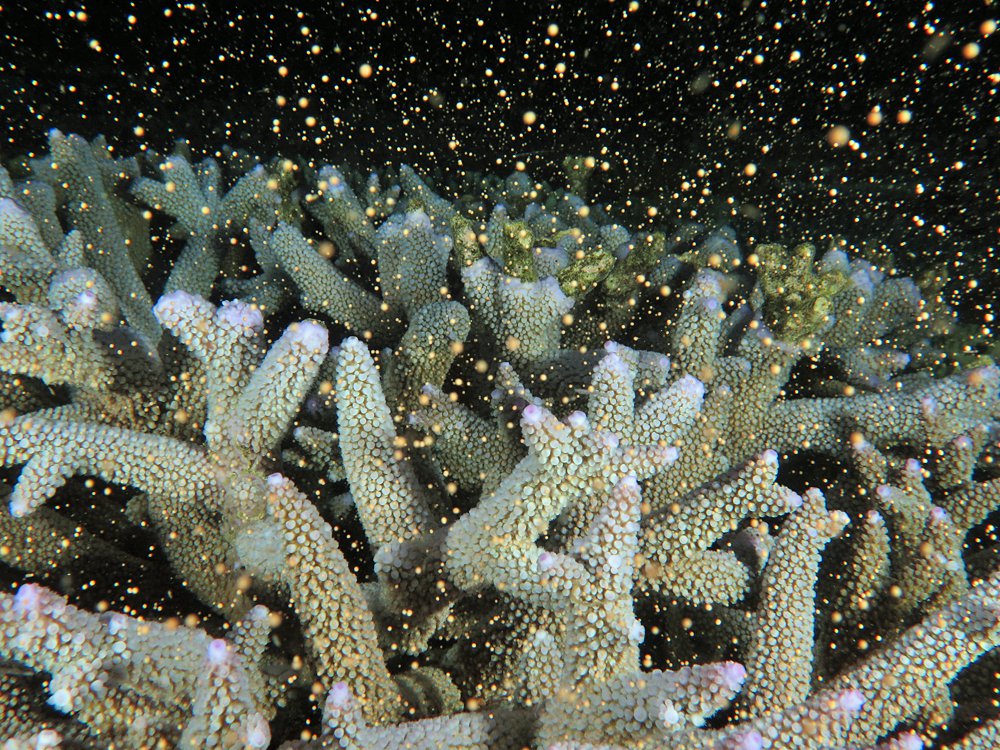News from LIRS: Big coral spawning event in 2022
Each month, a selected blog from the Lizard Island Reef Research Foundation (LIRRF) is featured at the Australian Museum. LIRRF supports scientific research and education at the AM’s Lizard Island Research Station on the Great Barrier Reef. This month, we feature: Big coral spawning event in 2022.
Most species of hard corals on the Great Barrier Reef take part in a mass spawning event over a short period, once a year. It’s a remarkable sight and, every year, most people at LIRS are keen to go out and see it – even if their research has nothing to do with it. This year was no different. Many of us went out over two nights, 11 and 12 November, and were rewarded both times.
The event starts a few hours after sunset and is triggered by the change in light level. Researchers who are doing aquarium studies that involve spawning can exploit that trigger to stagger spawning times – which is helpful when they have a lot to do in a very short time. By closing the door to the aquarium room and turning off the lights at about 3 pm on the day of spawning, corals inside are tricked into ‘thinking’ that it’s several hours earlier than it is, so they spawn earlier. Other corals in outdoor aquaria, exposed to the normal light regime, will spawn at the same time as corals on the reef, hours after the ones that experienced an earlier, false sunset.

© Lyle Vail.
The challenge is to work out exactly which night is THE night. At Lizard Island, it’s usually on the 3rd, 4th or 5th night after the full moon in November or December. Whether it’s November or December depends on when in the month the full moon occurs. If it’s late in the month, then November is by far the best bet. But if the full moon is early in the month, as it is this year, then a ‘split spawning’ is likely, with some corals spawning after the November full moon and others a month later.
This year, the full moon was on 8 November. Determined not to miss it, researchers at LIRS signed up to go out for a group snorkel on either the 3rd or 4th night after that. It’s always pitch black when we head out in boats at about 8:30 pm and navigation needs to be precise. Even with GPS, we place marker buoys with lights to assist at critical parts of the route where reefs are plentiful and the channel is narrow. The large waning moon rises while the spawning is happening, and it’s an amazing sight for the person who remains in the boat to watch over the snorkellers. Moonlight makes it much it easier to find the way back to the station at about 11 pm.
On 11 November, we went to Clam Garden in Watson’s Bay where the spawning was just beginning as we got into the water at about 9 pm. It built in intensity for more than an hour and the quantity of spawn was substantial but it wasn’t the ‘main’ night. Other island visitors had gone to North Point that night, about 2 km away, and they didn’t see any spawning.

© Anne Hoggett.
On the night of 12 November, the second team of LIRS people went to North Point where the coral community is vibrant, having recovered fantastically since the devastation wrought by cyclones and marine heatwaves in 2014-2017. There we were treated to a massive spawning event.
By 9 pm, there was already a lot of spawn in the water and a large proportion of Acropora coral colonies were visibly ‘setting’, with egg/sperm bundles bulging at the mouth of each polyp prior to being spawned. Then the bundles are released and they drift slowly towards the surface where a visible slick forms. There, the bundles eventually break apart into their microscopic components and sperm seek out eggs from a different colony, the corals’ one chance in a year to mix their gene pools.

© Anne Hoggett.
By the time we left at about 11 pm, most of the corals observed setting had spawned and the water was thick with it, reducing visibility markedly.

© Anne Hoggett.
As usual, there was a lot of other life in the water too. Many species of starfish, brittlestars and sea urchins spawn at the same time as corals, coming out at night from their daytime hiding places within the reef. And huge numbers of planktonic shrimps and worms are attracted to light so they congregate in the snorkellers’ torch beam, making it difficult to see beyond them. It’s an exciting time to be on the reef.

© Lyle Vail.
By Dr Anne Hoggett | Co-Director, Lizard Island Reef Research Station
To view the original blog, and to view more LIRS blogs, please go to: https://lirrf.org/big-coral-spawning-event-in-2022/
Support our research
Since its inception in 1978, The Lizard Island Reef Research Foundation has raised over $13.2 million to support science on the Reef.
The Research Station is seeking to sustain its current operations, expand its Fellowships & Grants program, enhance its function as a Biodiversity Hub and further energise its engagement with science students and visitors.
You can support these and other projects by making a donation. Donations are tax-deductible in Australia.


